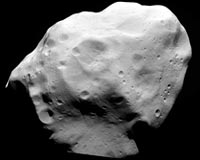 |
Munich, Germany (SPX) Jul 15, 2010 The ESA space probe Rosetta flew past the Lutetia planetoid at around 6 p.m. CEST on Saturday. The OSIRIS camera system, built and developed under the direction of the Max Planck Institute for Solar System Research in Katlenburg-Lindau, Germany, provided unique images of this rendezvous. They not only show a large number of craters on the surface of the celestial body, but also individual rocks and parallel grooves. With a resolution of around 60 metres per pixel, the images provide a fascinating view of Lutetia. "This is a completely new world, which no-one has ever seen before," says Max Planck researcher Holger Sierks, Head of the OSIRIS team. The planetoid, whose longest axis measures around 126 kilometres, is oval in shape. Its surface is marked by many craters, both large and small; in one of the larger craters, the images even show evidence of a landslide. In some parts, parallel grooves cover the cosmic rock, the origin of which is still unknown. The camera system had already focused on the asteroid on Saturday morning. At approximately 6 p.m. the Rosetta space probe was within 3,162 kilometres of the asteroid. "Both the wide-angle and the telephoto camera worked perfectly," reports Sierks. The Control Centre of the European Space Agency ESA passed the data collected during the fly-by directly to the Max Planck Institute, where researchers worked all day and into the night filtering images from the raw data. On Saturday at around 11 p.m. they presented their initial results. During the coming days and weeks the scientists want to further evaluate the images. It should then be possible to determine the colour of the asteroid and thus the chemical composition of its surface in more detail. They will also use data from other measuring instruments which were active during the fly-by as well. Since 2004, the Rosetta space probe has been en route to the Churyumov/Gerasimenko comet, and the plan is for the Philae lander to touch down on the comet in 2014. In September 2008, Rosetta passed the planetoid Steins.
Share This Article With Planet Earth
Related Links Max Planck Institute for Solar System Research Asteroid and Comet Mission News, Science and Technology
 Rosetta Triumphs At Asteroid Lutetia
Rosetta Triumphs At Asteroid LutetiaParis, France (ESA) Jul 14, 2010 Asteroid Lutetia has been revealed as a battered world of many craters. ESA's Rosetta mission has returned the first close-up images of the asteroid showing it is most probably a primitive survivor from the violent birth of the Solar System. The flyby was a spectacular success with Rosetta performing faultlessly. Closest approach took place at 18:10 CEST, at a distance of 3162 km. The imag ... read more |
|
| The content herein, unless otherwise known to be public domain, are Copyright 1995-2010 - SpaceDaily. AFP and UPI Wire Stories are copyright Agence France-Presse and United Press International. ESA Portal Reports are copyright European Space Agency. All NASA sourced material is public domain. Additional copyrights may apply in whole or part to other bona fide parties. Advertising does not imply endorsement,agreement or approval of any opinions, statements or information provided by SpaceDaily on any Web page published or hosted by SpaceDaily. Privacy Statement |